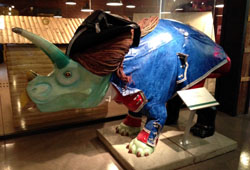
Although dinosaurs have been extinct for 66 million years, the giant reptiles of the past once roamed modern day Pittsburgh nonetheless as part of the Carnegie Museum of Natural History’s DinoMite Days in 2003. These prehistoric beasts apparently migrated to Pennsylvania from Zurich, Switzerland, where city officials contracted local artists to produce a series of life-size cow statues that were placed at various locales throughout the region in 1998.
Chicago businessman Peter Hanig convinced the Windy City to hold a similar event the following year – dubbed “Cows on Parade” – while Toronto’s “Moose in the City” used the Canadian mammal as their central focus in 2000. Other cities around the world quickly adapted the concept for their own communities as well, with Pittsburgh becoming a contemporary Jurassic Park just five years after Zurich was overrun by cows.
While dinosaurs may seem like an odd choice for a city built on the steel industry, Pittsburgh has played a central role in the study of dinosaurs since the latter part of the nineteenth century. Philanthropist Andrew Carnegie became fascinated with the extinct reptiles when he saw a newspaper cartoon depicting a dinosaur peeking into the upper floor window of a New York skyscraper. As a result, a group of paleontologists from Pittsburgh’s Carnegie Museum were sent to a Wyoming quarry, where a bone from a previously unknown species was soon uncovered.
The dinosaur was named Diplodocus carnegii after the industrialist giant and given the nickname Dippy. It was Pittsburgh steel workers, meanwhile, who invented the technique to mount fossilized bones onto the standing structures that are still found in museums around the world.
The 100 dinosaurs created for DinoMite Days in 2003 were sponsored by the leading corporations, institutions, and foundations of the region. Three specific species were chosen for the project – the armor-plated Stegosaurus, the rhino-like Torosaurus, and the ever-popular Tyrannosaurus rex. Although not life-size, the sculptures were formidable nonetheless and showcased a plethora of artistic styles and vivid imaginations, making the dinosaurs of DinoMite Days one of the most unique collections of artwork ever created within the Steel City.
The majority of the dinosaurs on display were more than just art, however, as they also told the story of Pittsburgh itself. Since dinosaurs were extinct, for instance, many of the artists spotlighting objects once associated with the city that no longer existed. Artist Jen Urich photographed abandoned steel mills in the area and then attached them to the body of a Stegosaurus as a remembrance of a bygone era, while Lucia Aguirre and Anne R. Savage used images of old bridges and buildings that are no longer part of the Pittsburgh landscape for their own Stegosaurus, nicknamed Intrados.
The theme was further expanded in Cynthia Cooley’s homage to Troy Hill and Shirley Yee’s “Lost Pittsburgh,” which featured photographs of such “extinct” local landmarks as Forbes Field and Horne’s Department Store.
Various Pittsburgh icons were likewise honored with their own unique dinosaurs. Fred Rogers from the classic children’s television show Mister Rogers’ Neighborhood was the focus of two of those creations, the “Neighborsaurus 143” by the Family Communications Art Crew and “Fredosaurus Rex Friday XIII” by Karen Howell that featured a Tyrannosaurus Rex outfitted with a red cardigan and tennis shoes.
Pittsburgh’s role in the French and Indian War, meanwhile, was highlighted by Barbara Anderson’s “George Washasaurus,” and Emily Escalante’s “Typosaurus” was plastered with actual headlines from the Pittsburgh Post-Gazette’s archives, with the newspaper itself sponsoring the dinosaur.
Pittsburgh-based sports teams were also represented during DinoMite Days, with a “Go Bucs!” Torosaurus that showcased the various emblems used by the Pirates over the years, while Chuck Dill honored football Hall of Fame linebacker Jack Lambert that likewise served as a homage to the Pittsburgh Steelers.
Although the past was explored by many artists, Pittsburgh’s transformation into a modern day metropolis was on display during DinoMite Days as well. “An Ecological History of Pittsburgh” by Jonathan Kline, Christine Brill, and Kelly Doctor, for instance, featured the flames and smoke that once engulfed the Steel City being extinguished by a new urban community filled with a lush, green forest. The “Burghosaurus” of Patricia Calderone contained vibrant images of Pittsburgh’s emergence as a high-tech city, whereas “Transitsaurus” reflected the regions’ evolution from street cars as the predominant mode of commuting to a more futuristic method that has yet to materialize.
Other elements of contemporary Pittsburgh were also given the dinosaur treatment in 2003. The Steel City’s achievements within the medical field were highlighted by the University of Pittsburgh Medical Center’s “Dinosurgeon” – which featured a Tyrannosaurus Rex in scrubs and holding a giant stethoscope – while Mellon Financial Services sponsored a Tyrannosaurus Rex attired in a business suit.
The PPG Industries’ entry in DinoMite Days, on the other hand, was coated with small pieces of mirror, reflecting the architectural design of PPG Place. And then there was the H.J. Heinz Company, which commissioned a red Torosaurus whose nose was shaped like a ketchup bottle.
Although the majority of the one hundred dinosaurs crafted for DinoMite Days were auctioned off at the end of the event, many of the creations still remain within both the Golden Triangle of downtown Pittsburgh and nearby Oakland, as well as within the walls of the Heinz History Center in the Strip District. The Steel City may no longer be a genuine Jurassic Park, but it is no longer the “steel city” of old either – something that the artists and sponsors involved with DinoMite Days made abundantly clear with the dinosaurs that invaded Pittsburgh in 2003.
Anthony Letizia

